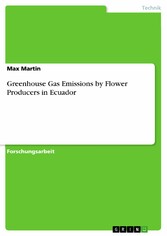Suchen und Finden
Greenhouse Gas Emissions by Flower Producers in Ecuador
Forschungsarbeit aus dem Jahr 2008 im Fachbereich Umweltwissenschaften, Note: 1.0, , Sprache: Deutsch, Abstract: The goal of this study is the calculation of greenhouse gas emissions, which occur during the production of Ecuadorian Flowers. Emissions are considered beginning with the production of raw materials up to the point where the flowers are sold to the final wholesale. In the beginning, the current status of international standardization is described with their relevance to the calculation. Currently there are no official regulations for CO2 calculations. Because most of the flowers are sold to Europe the Life Cycle Assessment (LCA) regulations ISO 14040 ff have been applied for the methodology and the creation of the system model. The importance of this standard has been pointed out, as it will be the basis for upcoming European CO2 regulations. Nowadays a widely accepted method is the greenhouse gas protocol, which has been used partly for the calculations because only few sectors (e.g. transportation) are covered. Chapter 2 introduces the model of flower production. The model includes all processes and the system boundaries. Significant factors contributing to the greenhouse gas emissions are defined as airfreight of flower to the final market, consumption of electricity and usage of fertilizers on the arm. The process of collecting data is subject of Chapter 3 including the last audit data from the Flower Label Program (FLP) as well as independently created inquiries and visits on the pilot farms. Chapter 4 comprises the calculation of CO2 emissions. The sources of the emissions factors are described in the beginning, which are mostly extracted from LCA software.
Alle Preise verstehen sich inklusive der gesetzlichen MwSt.













